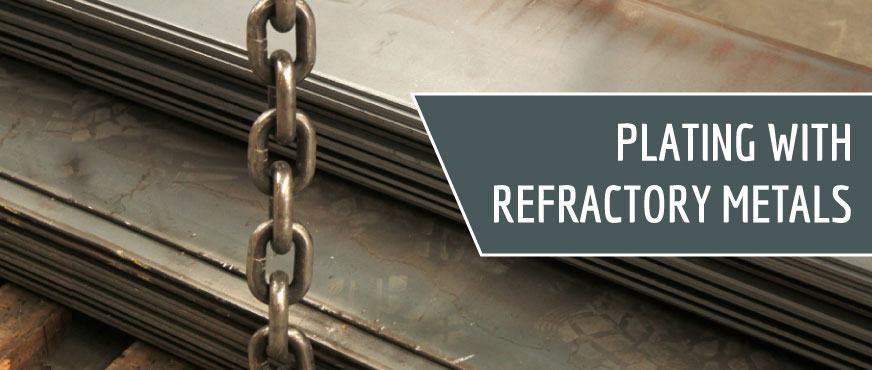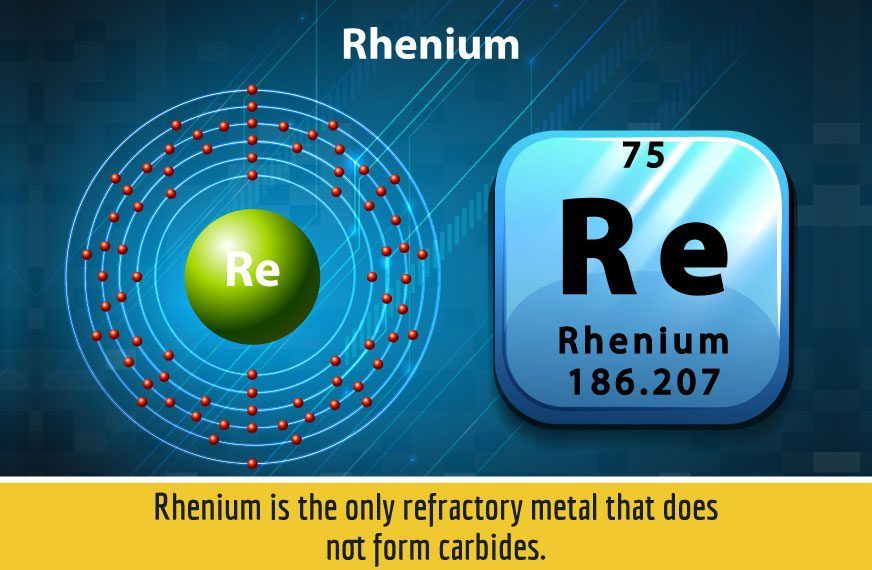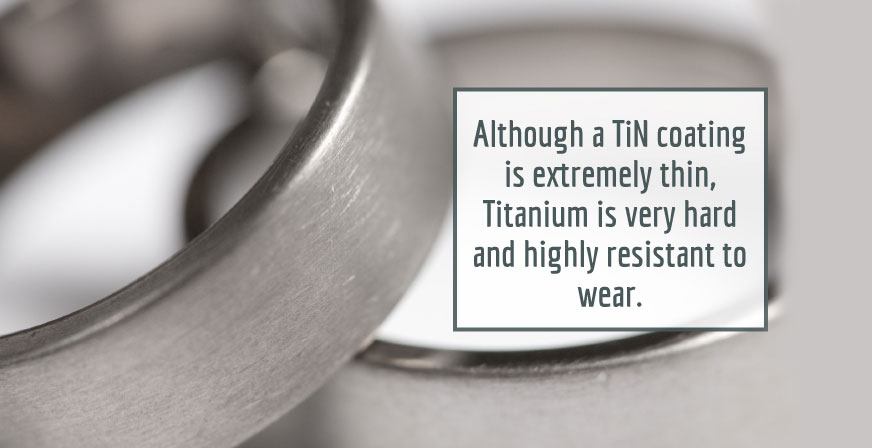
You’re undoubtedly familiar with “traditional” metals such as copper, gold, zinc and nickel, as well as their use and value in a wide range of manufacturing processes. You might be less familiar with a separate classification of metals known as refractory metals. The term “refractory” means this group of exotic metals possesses the remarkable ability to retain strength and hardness at extremely high temperatures. This property and several other unique characteristics make refractory metals extremely beneficial for various manufacturing applications.
Quick Links
What Are the Refractory Metals? | Plating With Refractory and Other Exotic Metals
Plating With Titanium | Plating with Tungsten
Plating with Molybdenum | Refractory Plating Services with SPC
What Are the Refractory Metals?
The group of refractory metals is composed of five primary elements:
- Tungsten (W)
- Molybdenum (Mo)
- Niobium (Nb)
- Tantalum (Ta)
- Rhenium (Re)
- Titanium (Ti)
- Several other exotic metals
Here’s a closer look at some of the unique properties and characteristics of each:
Tungsten
Tungsten was discovered in 1781 by a Swedish chemist named Karl Wilhelm Scheele. Tungsten literally means "heavy stone." The most abundant of all the refractory metals, tungsten also has the highest melting point at 3410°C (6170° F). This melting point is twice that of iron and ten times higher than lead. Tungsten also has one of the highest densities of all the metals.
While tungsten is extremely resistant to high temperatures, it exhibits a tendency to become volatile at temperatures above 1000° F. Consequently, it must be coated or surrounded by a protective atmosphere. This can be accomplished through the application of a silicon coating or noble metal cladding. In addition to its excellent heat resistance, tungsten offers good protection against atmospheric corrosion at ambient temperatures. It also offers resistance to water and sulfuric, nitric and hydrofluoric acids at room temperatures. Tungsten is known for its high level of electrical conductivity.
Because of its excellent heat resistance, tungsten is often used for welding electrodes and in manufacturing processes such as heating elements, trays, radiation shields and evaporation boats. It's strong electrically conductive properties and wear makes tungsten valuable in the manufacturing of electrical contacts.
Molybdenum
As with tungsten, Karl Wilhelm Scheele also played a significant role in the discovery of molybdenum, which also occurred in the late 18th century. However, it wasn’t until the late 19th century that a 96-percent-pure-metal version of the element was developed and made available for commercial applications. Molybdenum is now primarily utilized as an alloying element with steel in various manufacturing processes.
Molybdenum is similar to tungsten in its excellent ability to conduct heat and electricity, as well as its corrosion and wear resistance. In terms of corrosion resistance, molybdenum is effective against hydrofluoric acid, iodine and chlorine. In its unalloyed form, molybdenum offers superior thermal conductivity. Along with its heat conducting capabilities, this makes the element valuable for use in heat sinks. In fact, molybdenum’s thermal conductivity significantly exceeds that of iron, steel or nickel alloys.
Tantalum
Another discovery by a Swedish chemist, tantalum, was originally identified by Anders Gustaf Ekeberg in 1802. This element is extremely rare — it is approximately 15 times less abundant than gold. Tantalum is extremely difficult to dissolve and is one of the most corrosion-resistant materials known to man. It is also chemically inert, which makes it useful in the manufacturing of laboratory equipment. Tantalum is also sometimes used as a substitute for platinum. However, its primary use is for the production of capacitors found in electronic equipment such as mobile phones, computers and video game systems.
Like all refractory metals, tantalum has a high melting point (5468°F and 3020°C), and it is also highly reactive. Because of its excellent corrosion resistance, tantalum is frequently used in the manufacturing of vapor condensers, multi-tube heat exchangers and rupture diaphragms. Tantalum carbides may also be added to cemented carbides to produce hard cutting tools that reduce friction and resist mechanical shock. Additionally, when tantalum is combined with certain gases the released gases are useful in the manufacturing of electronic tubes.

Niobium
Niobium is often found together with tantalum and contains many of the same properties and characteristics. The major difference between the two is tantalum is approximately twice as heavy. The first known process for separating niobium and tantalum occurred in Europe in the mid-19th century. Its original use was as an alloy with steel, which remains its primary application to this day. Another common niobium application is in the manufacturing of magnets used in scientific research.
Alloying niobium with other metals such as iron, cobalt and nickel enhances its inherent refractory properties without adding weight. This makes niobium extremely valuable in the manufacturing of aerospace industry products such as rocket engines and gas turbines found in airplanes. However, niobium offers poor resistance to oxidation, which means it must be coated prior to use in these manufacturing processes.
Another key niobium benefit is its versatility. It can be fabricated to various strengths and elasticities. Compared to the other refractory metals, niobium also offers lower density and lower thermal neutron cross section.
Rhenium
Rhenium was originally discovered in 1925. It is not found on its own — rhenium ore must be extracted from other ores such as platinum, tantalite and molybdenite. In terms of melting point, rhenium is exceeded only by tungsten and carbon, and it also offers an extremely high density.
It's also the only refractory metal that does not form carbides. Other unique rhenium properties are as follows:
- It's resistant to attack by silver, zinc, tin and copper.
- It can dissolve in molten nickel and iron.
Rhenium is not highly susceptible to salt water corrosion and offers excellent resistance against hydrochloric acid. It is frequently alloyed with other metals for the purpose of increasing tensile strength and ductility. A molybdenum-rhenium alloy weld is a primary example. Other rhenium alloys are used in various manufacturing processes involving semiconductors, thermocouples, electrical contacts and thermionic converters.

Titanium
While titanium is not classified as one of the five main refractory metals, it does have many of the common refractory metal characteristics, such as a high melting point (3035° F) and excellent resistance against corrosion. Titanium was originally discovered in the late 18th century, but it wasn’t until the mid-1950s that it gained widespread use in manufacturing.
Titanium is also known for its remarkable — and extremely valuable from a manufacturing perspective — combination of light weight and superior strength. The lightness, strength and heat and corrosion resistance make titanium beneficial in various aerospace, marine and automotive manufacturing applications.
Request a free quote
For Plating on Refractory Metals
Plating With Refractory and Other Exotic Metals
Electroplating is a process used to provide a protective coating onto the surface of an underlying metal, which is referred to as a substrate, via a technique known as electrodeposition. With a traditional electroplating process, the metal part or object is placed into an aqueous electrolyte solution, which contains dissolved ions of the metal that provides the coating. An electrical current is then introduced, which provides a positive electrical charge to the ions, while the substrate is negatively charged. This causes the ions to be deposited onto the surface of the substrate.
Electroplating can be used for many purposes. A primary function is to make the substrate more resistant to the effects of corrosion. It can also make the object more electrically conductive and enhance its heat-resistance properties. Electroplating can even make the part more aesthetically appealing, such as when gold, silver or other precious metal is plated onto an otherwise dull metal surface.
Electroplating with refractory metals can differ from the traditional plating process in that it uses a non-aqueous media, typically molten salts. Fused-salt electrolysis is capable of generating compounds consisting of refractory metals. The electroplated coatings can contain the metals in their pure form or as various refractory metal alloys or compounds.
Fused-salt electrolysis involves a chemical reaction that is accompanied by an electron transfer. The process takes place in an electrochemical cell, which allows electrical energy to act as more of a chemical function to extract the refractory metal from the compound. During the electrolysis process, an electric current passes from the anode through the electrolyte to the cathode. The cathode material is then separated by the refractory metal.
Other exotic metal plating processes have been developed over the years. We’ll now take a closer look at the process of refractory metal plating with titanium, tungsten and molybdenum.
Plating With Titanium
As with most refractory metals, plating with titanium is not achievable with a conventional aqueous bath. It also cannot be plated by itself. One effective titanium plating process involves the use of an alloy of titanium and nitrogen to form titanium nitride (TiN), which is deposited via either physical or chemical vapor deposition as opposed to traditional electroplating. Although a TiN coating is extremely thin, it is very hard and highly resistant to wear. The thinness also makes it easy to maintain desired tolerances during plating.
In addition to being extremely wear-resistant, a titanium nitride coating is rated as very good in terms of biocompatibility. Medical device manufacturers frequently use a TiN coating to minimize the galling on sliding parts and components and to retain the sharp edges on surgical instruments. Other applications include lengthening the lifespan of cutting tools and machine tools. TiN coating’s attractive gold color makes it suitable for applications where aesthetic appeal is important.

Plating with Tungsten
Tungsten also cannot be plated by itself. However, plating with tungsten is possible with other iron group metals, particularly nickel. A nickel-tungsten-phosphorous alloy can be deposited via electroless plating. Unlike electroplating, electroless plating does not require the introduction of an electrical current. Instead, deposition occurs via chemical reaction.
While there are numerous electroless nickel alloys available, the nickel-phosphorous combination is the most common for industrial purposes.
The nickel-phosphorous-nickel alloy is relatively new with regard to its use in electroless plating, but its early results have been promising. The Ni-P-W electroless deposition process entails the creation of a plating bath that consists of nickel, tungsten salts and various stabilizers and buffering and complexing agents. While the phosphorous will increase the hardness of the coating, the introduction of even a small amount of tungsten can significantly enhance this property, as well as its corrosion resistance. Increasing the hardness will ultimately improve the wear resistance of the substrate.
Plating with Molybdenum
Plating with molybdenum (Mo) can be accomplished by alloying it with other metals. In particular, a chromium-molybdenum alloy can protect the substrate against wear and improve its corrosion resistance. The Mo content is extremely low, usually around one percent. However, pulse plating processes have been developed that enable effective Cr-Mo deposition with a Mo content of up to three times higher, while still producing crack-free deposits. With pulse plating, the DC current is introduced into the plating bath in short bursts instead of maintaining it continuously.
Hardness values of up to 900 KHM can be obtained when using pulse plating as opposed to regular DC plating, which represents an increase of nearly 20 percent. Additionally, the use of low-pulse frequencies tends to increase the molybdenum concentration in the deposit.
Refractory Plating Services From Sharretts Plating Company
Sharretts Plating Company has perfected the process of plating onto various refractory metals. For instance, we can plate nickel onto titanium, tungsten or molybdenum. We also offer an array of innovative refractory metal plating services that can be customized to your manufacturing applications.
When you choose exotic substrate plating services from SPC, you get the benefit of 90 years of metal finishing experience. We can work with you to develop a customized refractory metal plating process that will meet your manufacturing requirements and fit your budget. As a recognized leader in the metal finishing industry, you can count on us to develop a refractory metal placing process that will increase your operating efficiency and enhance your company’s bottom line.
Contact us to learn more about the benefits of refractory metal plating and to receive a no-obligation exotic substrate plating services quote. We’ll also be happy to schedule an on-site plating consultation at your convenience.
Additional Resources:
LEARN WHAT OUR MANY SATISFIED CUSTOMERS HAVE TO SAY ABOUT Us
"I would like to thank you for the help you have provided us in developing an electroless nickel plating technique on an unusual substrate. The sample platings you provided show that we should be able to reach our goals. I especially appreciate your willingness to take on an unusual job, with the uncertainties that that entails...We are looking forward to working with you in the future on our plating needs."
– Robert K.



